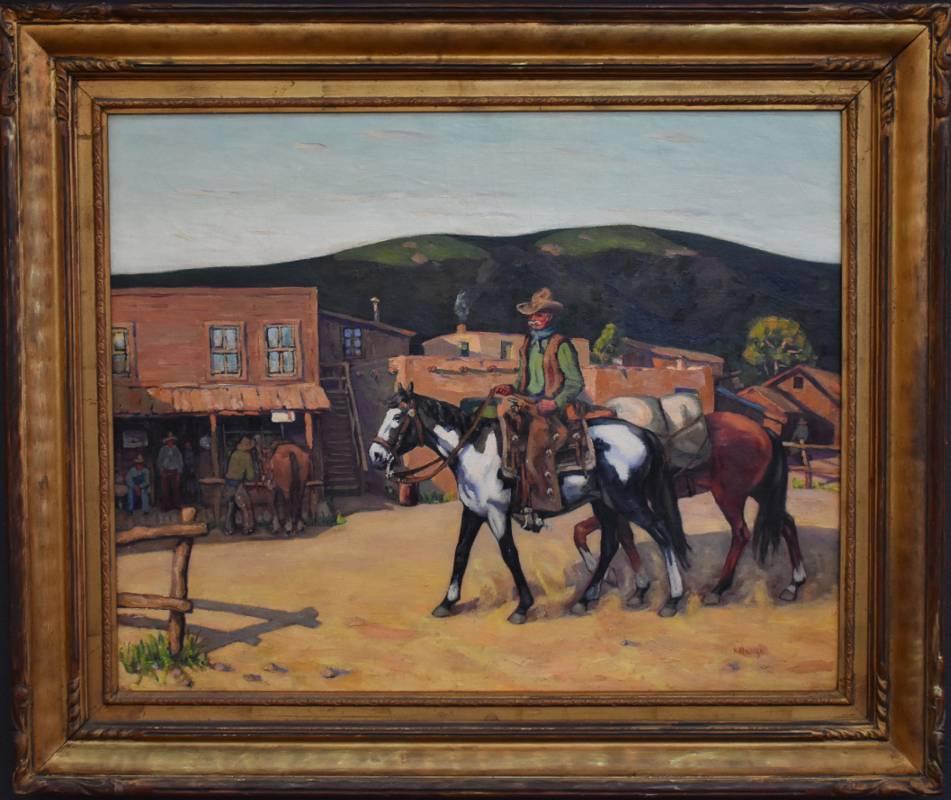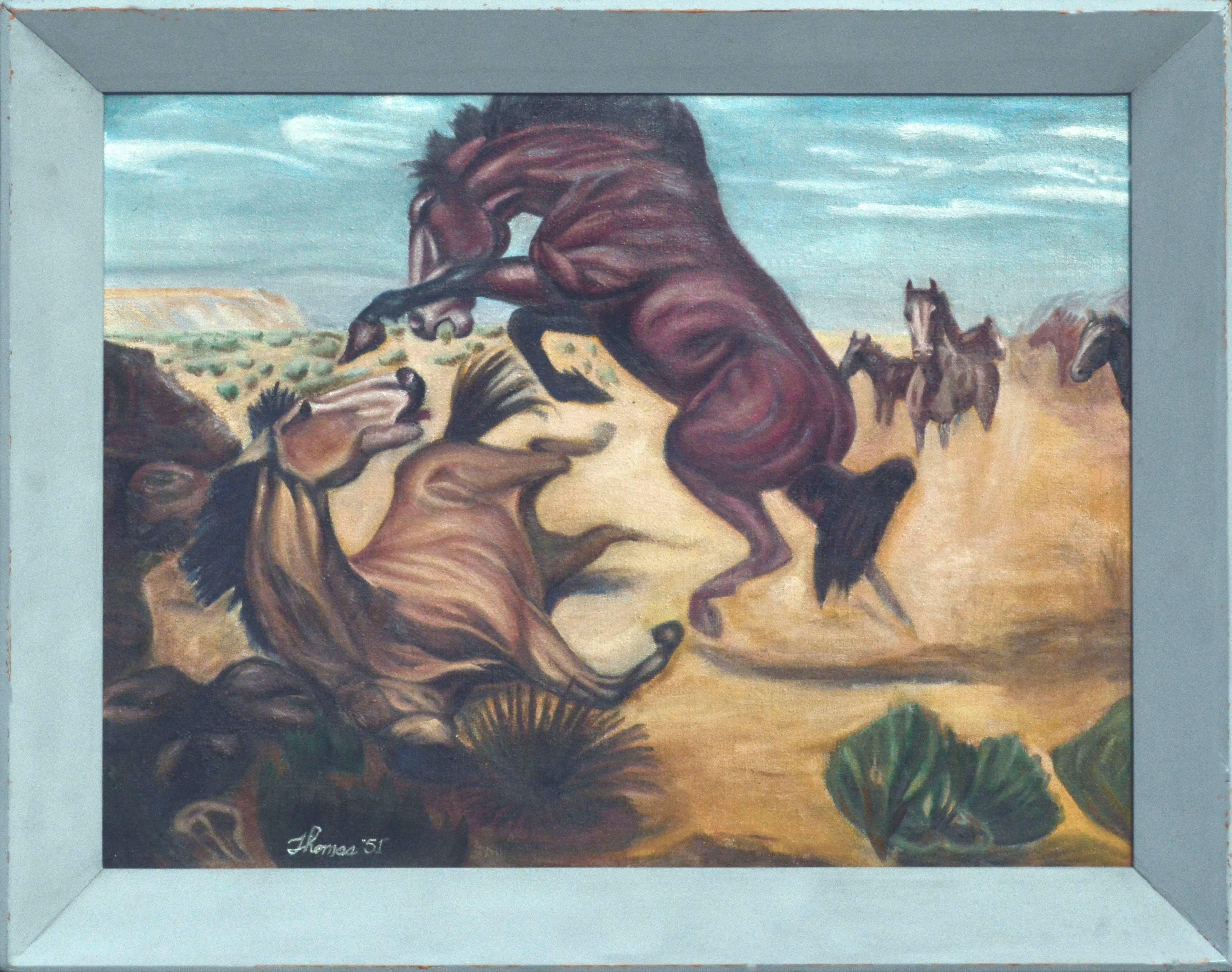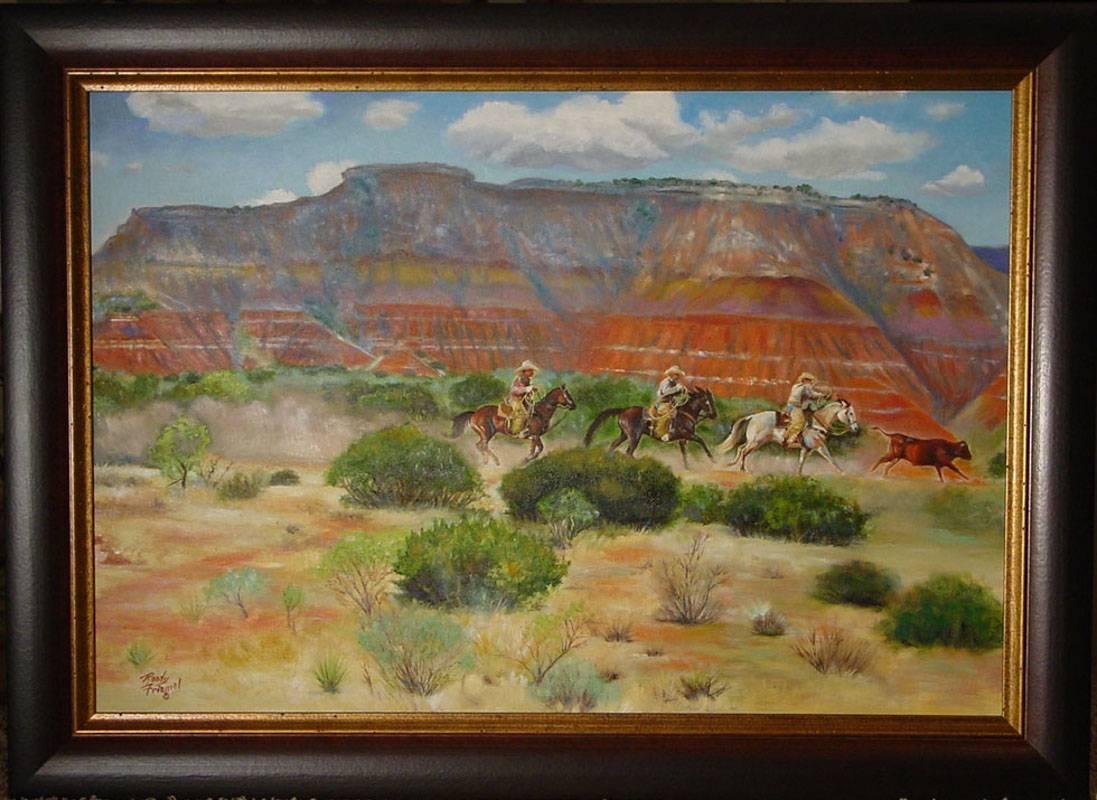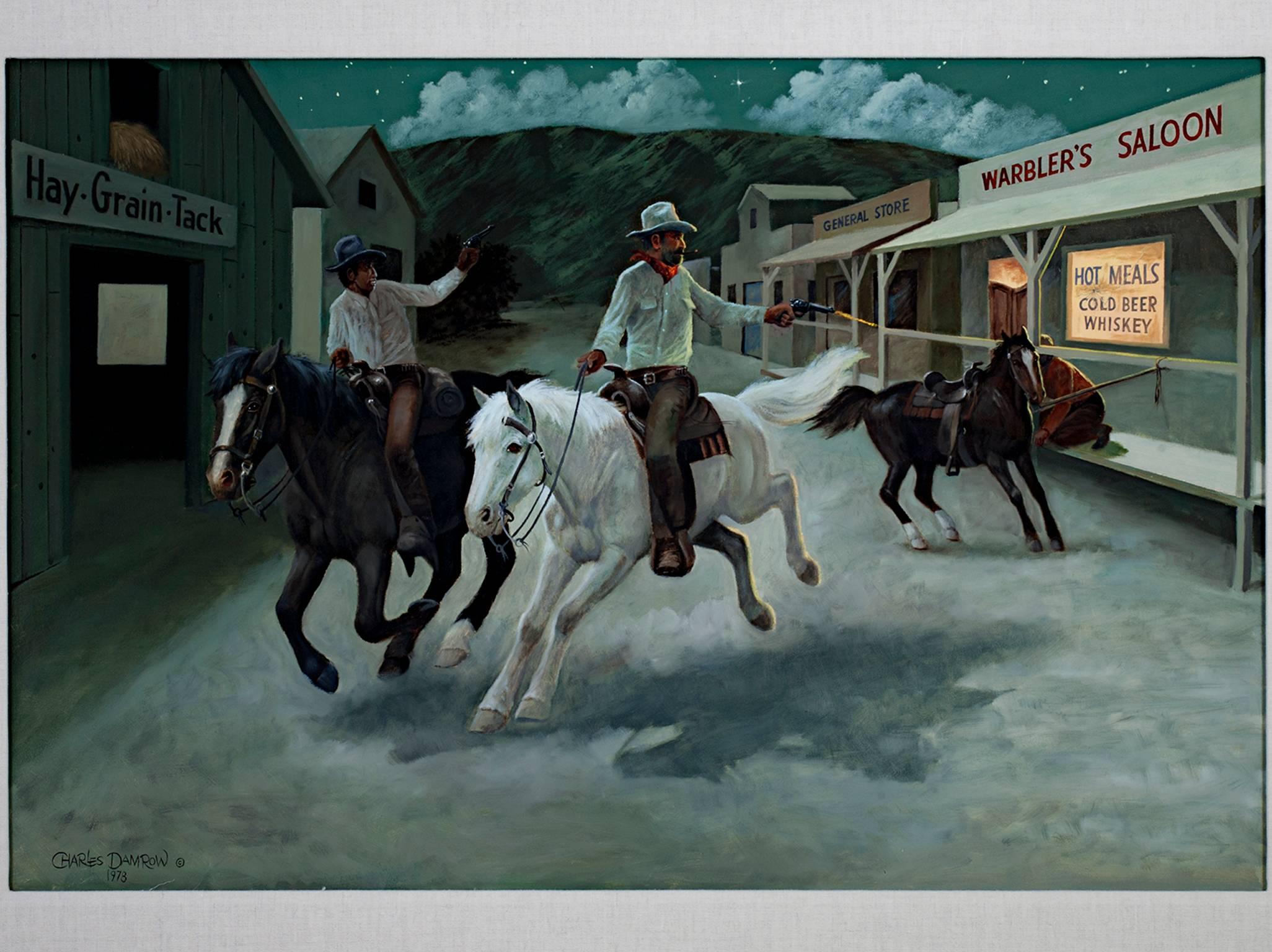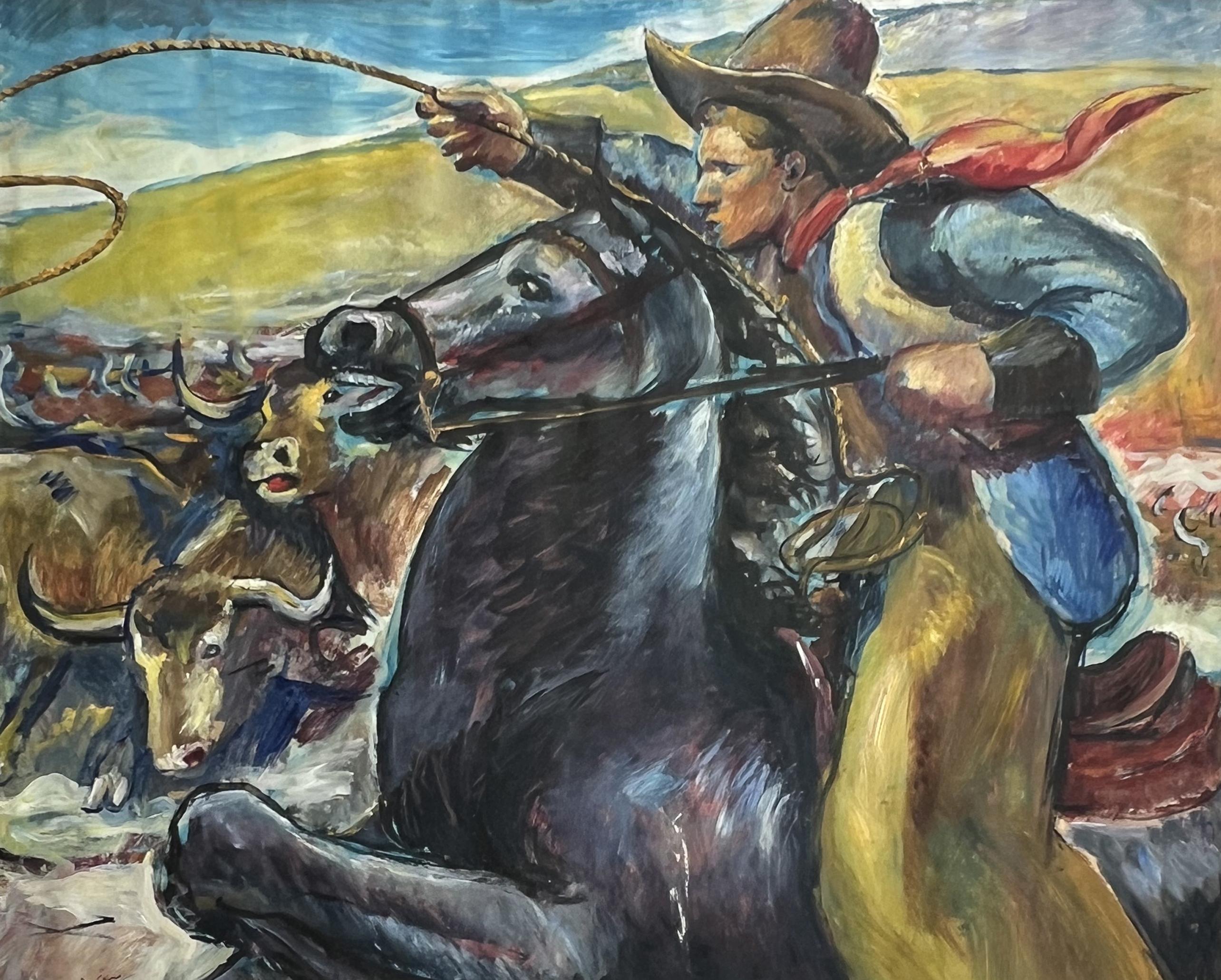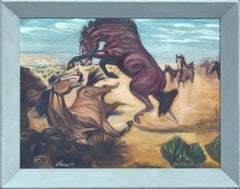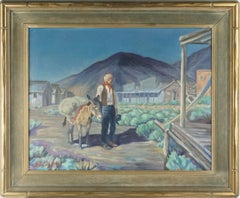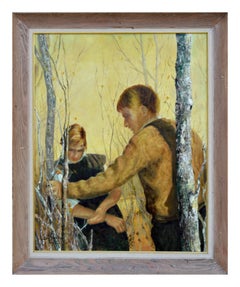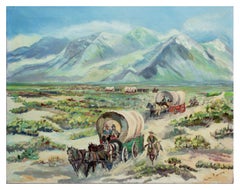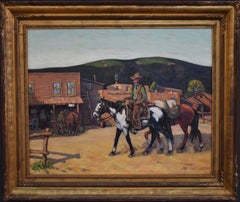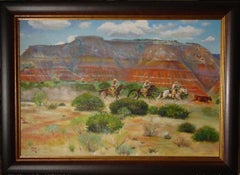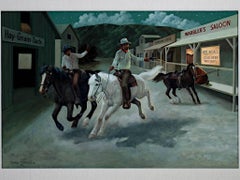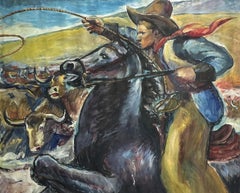Items Similar to "Sundown" Western Shoot Out, Mid Century Figurative Action Scene
Want more images or videos?
Request additional images or videos from the seller
1 of 13
Randy Steffen"Sundown" Western Shoot Out, Mid Century Figurative Action Scene1947
1947
$1,200
$1,50020% Off
£909.23
£1,136.5320% Off
€1,043.27
€1,304.0820% Off
CA$1,688.59
CA$2,110.7420% Off
A$1,856.23
A$2,320.2920% Off
CHF 975.55
CHF 1,219.4420% Off
MX$22,541.38
MX$28,176.7320% Off
NOK 12,169.73
NOK 15,212.1620% Off
SEK 11,529.96
SEK 14,412.4520% Off
DKK 7,786.16
DKK 9,732.7020% Off
About the Item
A dramatic mid-century western figurative action scene depicting a shootout in an old western town by Randy Steffen (American, 1917-1977), 1947. Several men, horses, and the sheriff join the fray with guns blazing on the dusty road in front of the general store.
Signed and dated "Randy Steffen '47" in the lower right corner.
Titled "Sundown" on verso, along with info about the piece, including signature and date.
Presented in a wood frame. Image size: 24"H x 18"W.
Randy Steffen (American, 1917 - 1977) was born on a ranch in Texas and grew up around horses, which set the stage for his becoming a western artist, writer and researcher. He graduated high school in 1935, receiving an appointment to the United States Military Academy at West Point. While attending Stanton Preparatory Academy, a prerequisite for West Point, he waited tables and gave riding lessons. Soon after starting at West Point, he traded places with another cadet and transferred to the Naval Academy, graduating as an ensign in 1940. He was then deployed to Europe during WWII.
After the war, Steffen worked in civil engineering for a short period of time, and soon leased a ranch in Nevada, where he got involved in the training of horses. During this time, he began creating and selling art works, marking the beginning of his artistic career.
He was a man of many talents, and in 1948, he moved to Colorado Springs to design a new office building for the Western Horseman magazine. He trained polo ponies in California; worked as managing editor of a horse magazine in Cisco, Texas; and worked as a stuntman and stand-in for western movie stars in Hollywood. Here he began writing articles on a variety of topics, establishing a reputation as a solid writer and researcher. Among his articles are: United States Military Saddles; The Civil War Soldier; The American Sidesaddle; Indian-Fighting Cavalryman; Stagecoach! The Abbot-Downing Story; Saddles Through History; Bits Through History; Horse Equipment of the Plains Indians; and The American Stock Saddle.
On the basis of his extensive research about the personal gear and horse gear of the United States Cavalry, Steffen wrote a series of four books about the uniforms, arms, accouterments, and equipment of the cavalryman, entitled: The Horse Soldier 1776-1943, published in 1977, 1978, and 1979 by the University of Oklahoma Press.
In the late 1960s, Steffen concentrated on creating bronze sculptures and paintings, continuing through the mid-70s, though his health was failing him.
In 1974, he received one of two Americana Awards from American Airlines for his work in preserving American history. Then the Dallas area Bicentennial Commission selected him to receive its Bicentennial Award for promotion of American history through art and writing. They also nominated him for the Freedom Foundation George Washington Award, and on February 2, 1976, he was honored with the American Exemplar Award at Valley Forge.
Randy Steffen died January 17, 1977, at the age of 59. His ashes were scattered at the wildlife refuge near Cache, Oklahoma.
- Creator:Randy Steffen (1917 - 1977, American)
- Creation Year:1947
- Dimensions:Height: 28.25 in (71.76 cm)Width: 22.25 in (56.52 cm)Depth: 1.25 in (3.18 cm)
- Medium:
- Movement & Style:
- Period:
- Condition:Scratches on frame (minimized). Vintage frame shows signs of wear consistent with age and history. Minor cosmetic issues minimized, but may not be restored to original condition. New hanging hardware installed.
- Gallery Location:Soquel, CA
- Reference Number:Seller: JT-DBH68471stDibs: LU5428292402
About the Seller
5.0
Platinum Seller
Premium sellers with a 4.7+ rating and 24-hour response times
Established in 1986
1stDibs seller since 2014
3,000 sales on 1stDibs
Typical response time: <1 hour
- ShippingRetrieving quote...Shipping from: Soquel, CA
- Return Policy
Authenticity Guarantee
In the unlikely event there’s an issue with an item’s authenticity, contact us within 1 year for a full refund. DetailsMoney-Back Guarantee
If your item is not as described, is damaged in transit, or does not arrive, contact us within 7 days for a full refund. Details24-Hour Cancellation
You have a 24-hour grace period in which to reconsider your purchase, with no questions asked.Vetted Professional Sellers
Our world-class sellers must adhere to strict standards for service and quality, maintaining the integrity of our listings.Price-Match Guarantee
If you find that a seller listed the same item for a lower price elsewhere, we’ll match it.Trusted Global Delivery
Our best-in-class carrier network provides specialized shipping options worldwide, including custom delivery.More From This Seller
View All"King of the Range" - Mid Century Western Fighting Stallions
By Bernard Preston Thomas
Located in Soquel, CA
Wonderful and dynamic western painting of two wild fighting stallions by listed artist Bernard Preston Thomas (American, 1918-1992), dated 1951. Signed and dated lower left corner and on verso. Image size: 28"H x 36"W. Presented in rustic painted frame size: 34"H x 41"W x 3"D.
Originally from Sheridan, Wyoming, he loved football and art, giving up the sport to concentrate on a career in art. Thomas graduated from Woodbury College in Los Angeles with a Bachelor of Science degree, earning the Leo Youngsworth Award for outstanding senior art student at Woodbury.
He became a camouflage technician at the outbreak of WWII and caught the attention of General Patton...
Category
1950s American Modern Animal Paintings
Materials
Canvas, Oil
$2,040 Sale Price
20% Off
The Prospector at Dusk, Early 20th Century Cowboy w Donkey Figurative Landscape
By George Sanders Bickerstaff
Located in Soquel, CA
A rare figurative for this well-listed California artist of a Nevada mining town landscape with prospector and burro by George Sanders Bickerstaff (American, 1893 - 1954), circa 1920. Signed lower right corner. Presented in patinated gilt-toned wood frame. Image size: 24"H x 30.5"W. Frame size: 32.5"H x 38"W.
Bickerstaff was active/lived in California, Arkansas. George Bickerstaff is known for Landscape, coastal views, still life, western painting.
Landscape painter. Born in Marianna, Arkansas on April 12, 1893. Bickerstaff was a self-taught artist except for a brief period at the Art Institute of Chicago. He led a peripatetic existence before moving to California in 1922. His early years were spent in San Diego, Los Angeles, and Van Nuys.
He exhibited often in the latter with Paul Lauritz. A prolific oil painter of mountain and desert scenes, his landscapes often include eucalypti as well as rolling hills of California wildflowers...
Category
1920s American Impressionist Figurative Paintings
Materials
Canvas, Oil
Mid Century Figurative -- Adventures - Duleich
Located in Soquel, CA
Mid century figurative of romantic adventures by Duleich (American, 20th Century). Presented in a wooden frame. Signed "Duleich '59" lower left. Image size, 30.25"H x 24"W. Framed si...
Category
1950s American Impressionist Figurative Paintings
Materials
Canvas, Oil
$1,260 Sale Price
20% Off
Oregon Trail, Vintage 1970s Western Figural Landscape
Located in Soquel, CA
Evocative oil painting of pioneers traveling by wagon train across the vast western plains by California artist Harry Roerade (American 1908-1987), circa 1...
Category
1970s American Impressionist Landscape Paintings
Materials
Paper, Watercolor
$716 Sale Price
20% Off
Mid Century Desert Cactus Sunset Landscape by Russell Dale Moffett
By Russell Dale Moffett
Located in Soquel, CA
Mid Century Desert Cactus Sunset Landscape by Russell Dale Moffett
Experience the splendor of the desert at sunset in this stunning mid century landscape by Russell Dale Moffett (American, 1899-1984). This striking 1959 landscape features tall cacti casting long shadows as they are bathed in warm light by an orb of golden sun. As the sky lights up in a burst of color, the desert sands are illuminated in a beautiful warm glow. Russell Dale Moffett's impressive attention to detail and realistic style leave a lasting impression on the viewer.
Signed "Russell Dale Moffett" lower right.
Presented in a giltwood frame.
Canvas size: 24"H x 30"L.
Framed size: 37"H x 31"W x 2"D.
Regarded as a quintessential outsider artist, Russell Dale Moffett’s work has begun to attract collectors’ serious attention. Born in Indiana, by 1942 he had settled in San Diego and was a muralist. A large proportion of his output was created to decorate the bars and dives of those honky-tonk neighborhoods in downtown San Diego that catered to the soldiers and sailors that passed through in the boom war years when it was a liberty town. Much of his work must have been lost to gentrification and urban renewal. Some of it is just now coming to light. One of eight lost Hawaiian Surfer...
Category
Mid-20th Century Impressionist Landscape Paintings
Materials
Canvas, Oil
$5,200 Sale Price
20% Off
Wells Fargo Express, Gold Country -- Columbia, California
By Cecil F. Chamberlin
Located in Soquel, CA
Charming oil painting of the Wells Fargo Express Office building in the gold country town of Columbia State Historic Park in Columbia, California by Cecil ...
Category
1950s American Impressionist Landscape Paintings
Materials
Canvas, Oil, Illustration Board
$1,320 Sale Price
20% Off
You May Also Like
"Down By The Rio Grande" Texas Cowboy Western Dallas Artist Fred Darge 1900-1978
Located in San Antonio, TX
Fred Darge (1900-1978) Dallas Image Size: 24 x 30 Frame Size: 32 x 38 Medium: Oil, "Down By The Rio Grande"
Biography
Fred Darge (1900-1978)
Friedrich Ernst Darge Born: March 1 1900 Rendsburg, Germany Died: April 10 1978 Dallas, Texas Entered the U.S. ; Jan. 14 1923 at Port Arthur, Texas. By 1924 he was in Chicago painting under the W.P.A. Artists policy and attending the Art Institute of Chicago from where he graduated. While in Chicago he painted and made model sail boats...
Category
1940s Impressionist Landscape Paintings
Materials
Oil
"Our Real Work Is In The Valley" West Texas Cowboy scene
By Randall Friemel
Located in San Antonio, TX
Randall Friemel (1970 - present) Texas Artist Image Size: 24 x 36 Frame Size: 32 x 44 Medium: Oil "Our Real Work Is In The Valley".
Biography
Randall Friemel (1970 - present)
Randall is a Ecclesial / Liturgical artist by trade. He began drawing many years ago. After using colored pencils for several years, he began experimenting with oil and found painting would not be much different. He has painted "Stations Of The Cross" for many churches throughout Texas. Randall has studied under Jack...
Category
2010s Impressionist Landscape Paintings
Materials
Oil
"Saloon, " am Oil on Board signed by Charles Damrow
By Charles Damrow
Located in Milwaukee, WI
"Saloon" is an original oil painting on board signed and dated in the lower left by the artist Charles Damrow. It depicts two cowboys on horseback with guns aiming at the saloon as they ride away. There are bullet-holes in the window of the saloon building and the horse tied...
Category
1970s Other Art Style Figurative Paintings
Materials
Oil
Cowboys Horses Cattle WPA American Scene Social Realism Mid 20th Century Modern
By Jo Cain
Located in New York, NY
Cowboys Horses Cattle WPA American Scene Social Realism Mid 20th Century Modern
Jo Cain (1904 – 2003)
Cowboy
33 3/4 x 36 inches
Oil on paper, c. 1930s
Signed...
Category
1930s American Realist Figurative Drawings and Watercolors
Materials
Paper, Oil
"Cheyenne Wyoming Frontier Days"
Located in San Antonio, TX
Pepper Brown
(1926-1999)
Alpine Artist
Image Size: 9 x 13
Frame Size: 16 x 20
Medium: Ink Drawing
Dated 1942
"Cheyenne Wyoming Frontier Days" Harry Hart W...
Category
1940s Impressionist Animal Drawings and Watercolors
Materials
Ink
Bareback Bronco Horse Framed Mid 20th Century Rodeo Cowboy Original Painting
By John Rattenbury Skeaping
Located in Sutton Poyntz, Dorset
John Rattenbury Skeaping.
English ( b.1901 - d.1980 ).
Rodeo. Bareback Bronco, 1966.
Gouache On Paper.
Signed & Dated Lower Right.
Image size 21.3 inches x 29.1 inches ( 54cm x 74...
Category
Mid-20th Century American Impressionist Animal Paintings
Materials
Paper, Gouache
